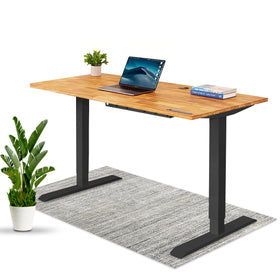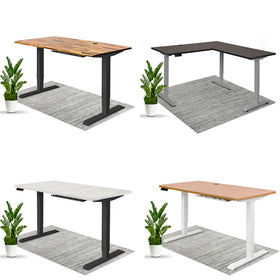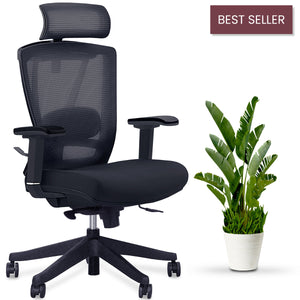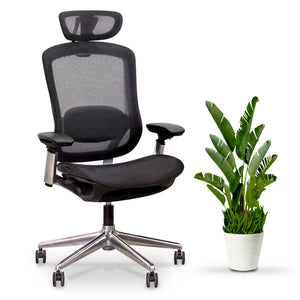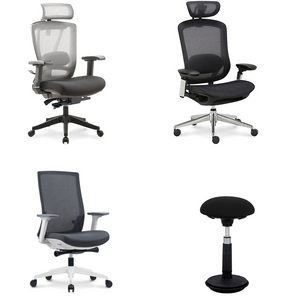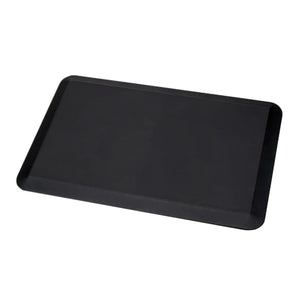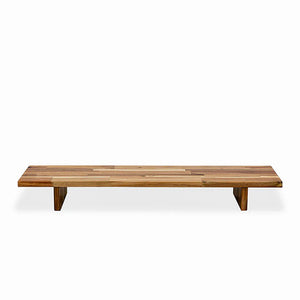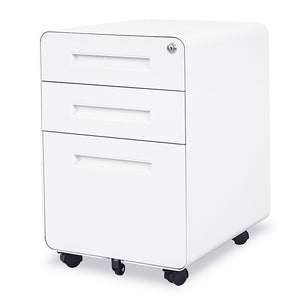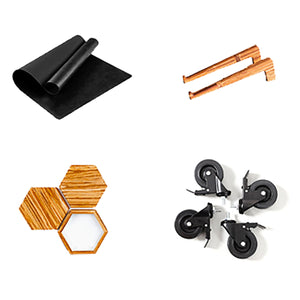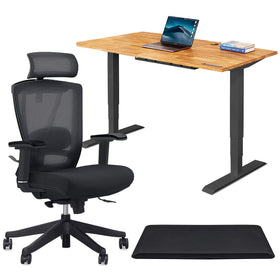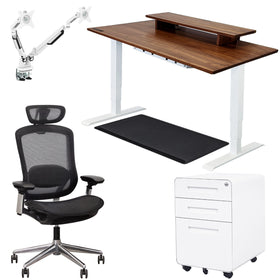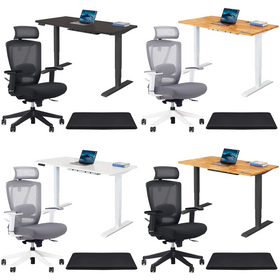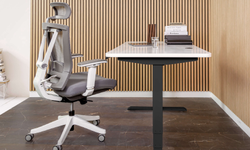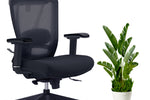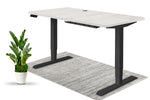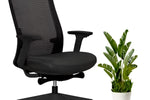-
Leather vs Mesh Office Chairs: The Pros and Cons April 11, 2024
-
7 Easy Soundproofing Hacks for Your Home Office April 2, 2024
-
How Prolonged Sitting Silently Damages Your Health March 21, 2024
-
How to Clean & Maintain Solid Wood Office Furniture March 7, 2024
-
AeryChair - Ergonomic Chair530 CAD
-
Standing Office DeskFrom835 CAD
-
GrinChair - Ergonomic Chair380 CAD
-
Home Office Standing DeskFrom715 CAD
How to Clean & Maintain Solid Wood Office Furniture
Solid wood office furniture brings a warm, natural element that can enhance the overall ambiance of practically any interior, whether a traditional shared workspace or a cozy home office. Its timeless beauty and inherent durability make it a favored choice among professionals who value both aesthetics and functionality in their work environments.
The rich textures and deep colors of solid wood pieces can transform mundane office spaces into sophisticated and inviting areas that encourage productivity and creativity. However, the longevity and visual appeal of solid wood furniture greatly depend on the level of care and maintenance it receives. Without proper upkeep, even the finest pieces can succumb to wear and damage over time. Therefore, understanding the essentials of wood care is crucial for anyone looking to preserve the charm and integrity of their solid wood furniture for future generations to admire and use.
As experts in the world of solid wood standing desks and accessories, our team at EffyDesk is well-versed in how to preserve this natural material. In this guide, we'll cover everything you need to know about keeping your solid wood office furniture in pristine condition.
Understanding Solid Wood
Before we dive into the specifics of maintenance tips, it's essential to understand the fundamental characteristics of solid wood. Wood, as a natural material, depends on its surroundings and is particularly sensitive to environmental changes. It has the innate ability to expand and contract in response to variations in humidity and temperature. This natural responsiveness not only contributes to the unique charm and organic beauty of wood but also showcases the importance of special care and maintenance techniques.
The distinctive grain patterns and textures that wood displays can enhance or change subtly over time, reflecting the wood's ongoing interaction with its environment. By acknowledging and respecting these characteristics, we can adopt maintenance practices that not only preserve but also celebrate the living quality of wood, ensuring that it continues to bring warmth and elegance to office spaces for many years to come.
Daily Cleaning
Dusting
Dust can be abrasive and can scratch the wood's surface over time. Use a soft, clean cloth, preferably microfiber, to gently dust the furniture. Microfiber cloths are effective at trapping dust without the need for chemical sprays. Dust in the direction of the grain to avoid scratches.
Cleaning
For regular cleaning, a damp cloth can be used. Make sure the cloth is just slightly damp, not wet, to avoid saturating the wood, which can cause warping or discoloration. Wipe the surface in the direction of the grain, and immediately follow with a dry cloth to remove any excess moisture.
Avoid using all-purpose cleaning sprays unless they are specifically labeled safe for wood. Harsh chemicals can damage the finish of your wood furniture.
Dealing With Spills
Spills should be wiped up immediately with a dry cloth. If a spill has dried or left a sticky residue, lightly dampen a cloth with water or a mixture of water and mild dish soap. Wipe gently, then dry immediately. For stubborn spots, it may be tempting to use a scrub pad, but this can scratch the finish. Instead, consider consulting a professional.
Deep Cleaning and Polishing
Over time, your furniture may need a deeper clean or polish to restore its shine. This should be done sparingly, as over-polishing can lead to a buildup that dulls the surface.
Deep Cleaning: Use a wood cleaner designed for your type of finish. Apply the cleaner with a soft cloth, working in the direction of the grain, and wipe clean with a second dry cloth.
Polishing: Choose a wax-based polish for traditional finishes or a silicone-based polish for a more contemporary finish. Apply a thin layer with a soft cloth, again working in the direction of the grain. Buff with a clean cloth to a shine.
Protecting the Surface
Use Coasters and Pads
Do you rely on your morning coffee to fuel your workday? Water rings from cups or damage from hot items can be difficult to remove. Always use coasters for drinks and protective pads under hot dishes or electronic devices.
Avoid Direct Sunlight
Prolonged exposure to direct sunlight can fade and damage wood. Position your furniture away from direct sunlight, or use blinds, curtains, or UV window films to protect it.
Maintain Humidity Levels
Extreme changes in humidity can cause wood to expand and contract, leading to warping or cracking. Try to maintain a consistent humidity level in your office, ideally between 40% and 60%. This can easily be achieved by keeping a dehumidifier in your workspace.
Addressing Scratches and Damage
For minor scratches, a furniture marker or crayon that matches the wood finish can be used to fill in and camouflage the scratch. Deeper scratches and damage may require sanding and refinishing, which is best left to professionals. If however, you’re a DIY enthusiast, we’ve provided a few details on how to refinish solid wood furniture below.
How to Refinish Solid Wood Furniture
Refinishing solid wood furniture can breathe new life into tired, worn pieces, restoring their natural beauty and protecting them for years to come. The process begins with carefully preparing the surface by cleaning it and then sanding it down to remove the old finish, being mindful to move in the direction of the wood grain to avoid scratches. Start with coarse sandpaper for removing the old layers and gradually move to finer grits for a smooth finish. Once the surface is evenly sanded and free of old stains or varnish, it's crucial to thoroughly clean away any dust before applying a new finish.
Depending on the desired look, you can choose between various finishes such as stain, oil, or polyurethane, applying it with a brush or a cloth according to the manufacturer's instructions. Applying multiple thin coats, allowing sufficient drying time between each, will yield the best results. Finally, light sanding between coats can enhance the smoothness and adherence of the finish. Refinishing not only enhances the appearance of solid wood furniture but also offers an opportunity to customize the piece to fit new decor themes or personal tastes.
Regular Inspections
Periodically check your furniture for loose screws or hinges, especially in pieces that see a lot of use, like desks and chairs. Tightening these can prevent further damage and extend the life of your furniture.
Professional Help
For significant repairs, refinishing, or if you're unsure how to treat a particular issue, seeking professional help is advisable. A professional can offer services that will restore your furniture without compromising its integrity or value.
Solid wood office furniture is an investment that can last a lifetime with proper care. By following these tips for daily cleaning, protection, and maintenance, you can ensure that your furniture remains beautiful and functional for years to come. Regular care, along with a bit of attention and love, will keep your solid wood furniture in top condition, allowing it to stand the test of time. If you are considering a solid wood standing desk like our Wildwood option, our team is always happy to answer any questions you may have regarding care and maintenance.







